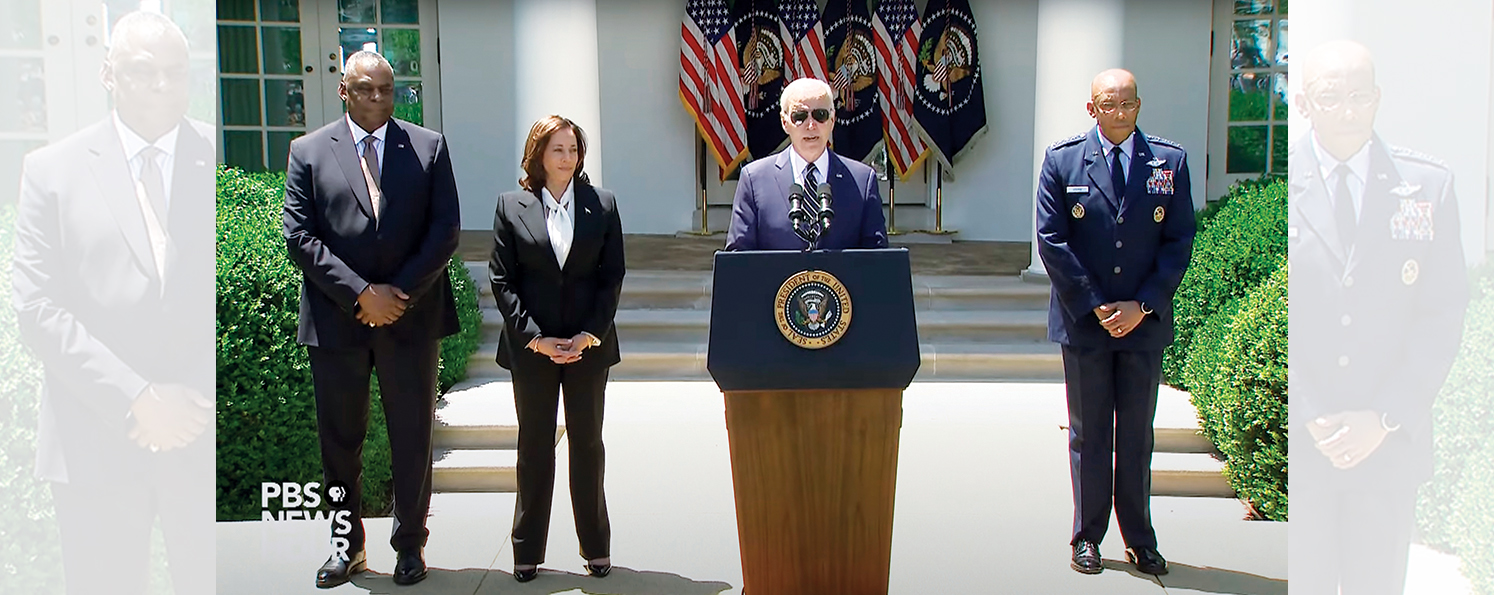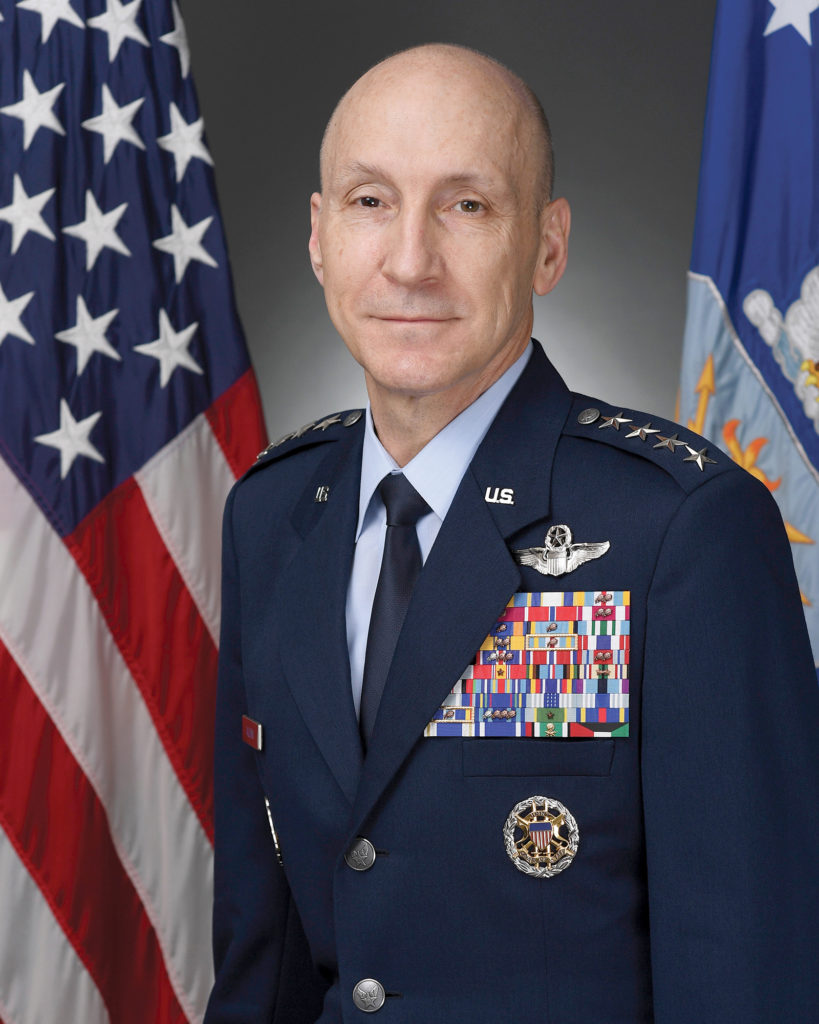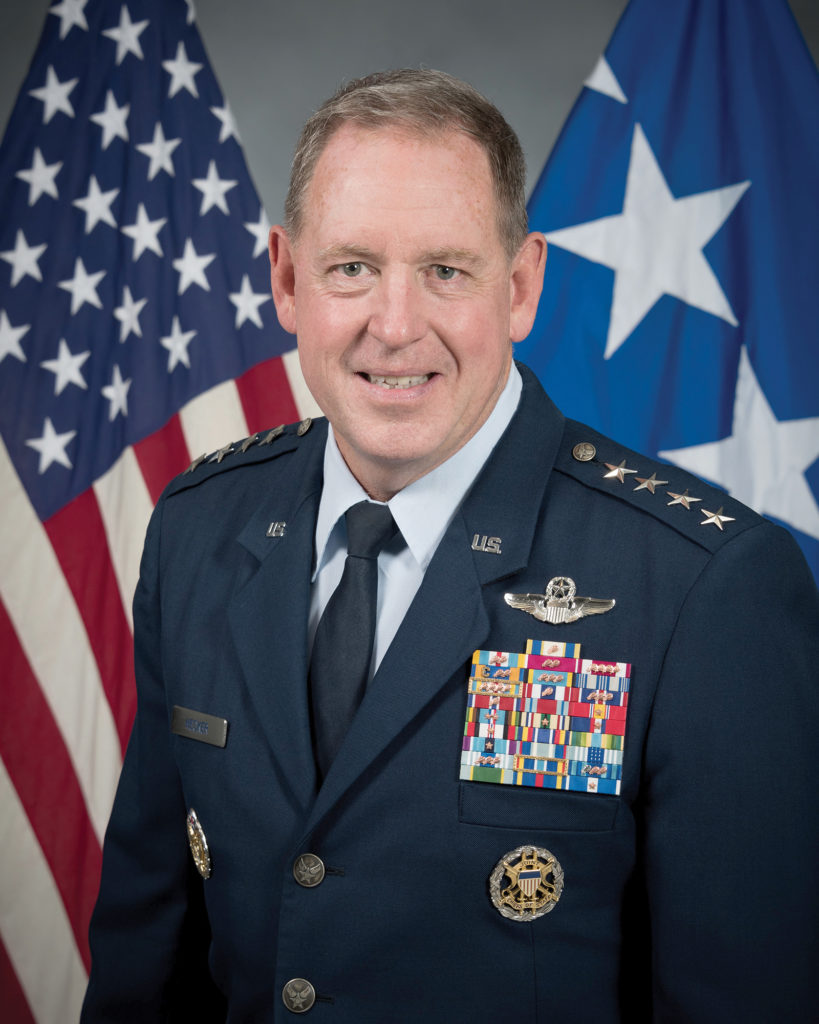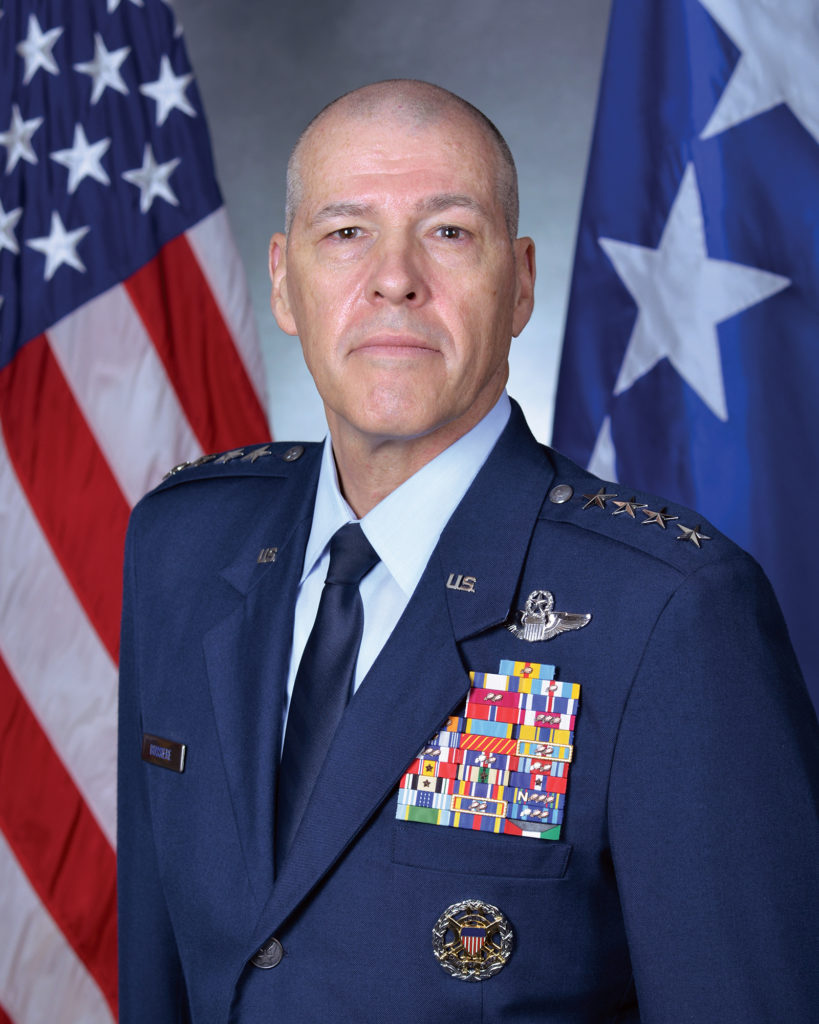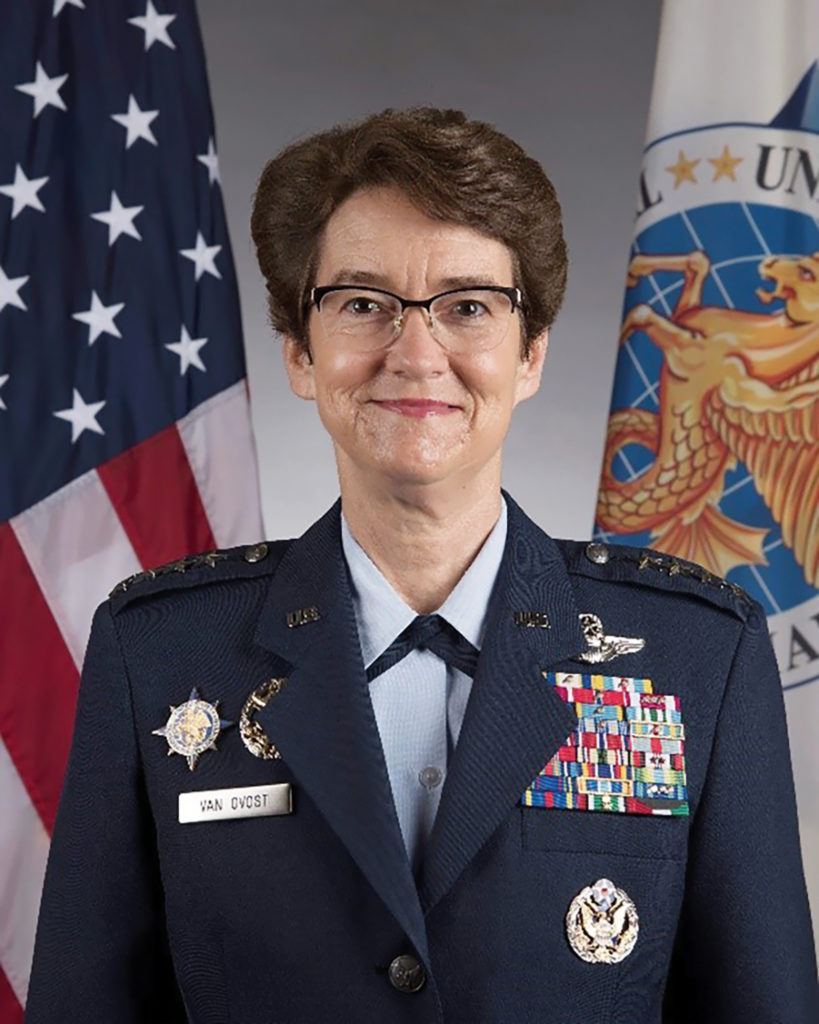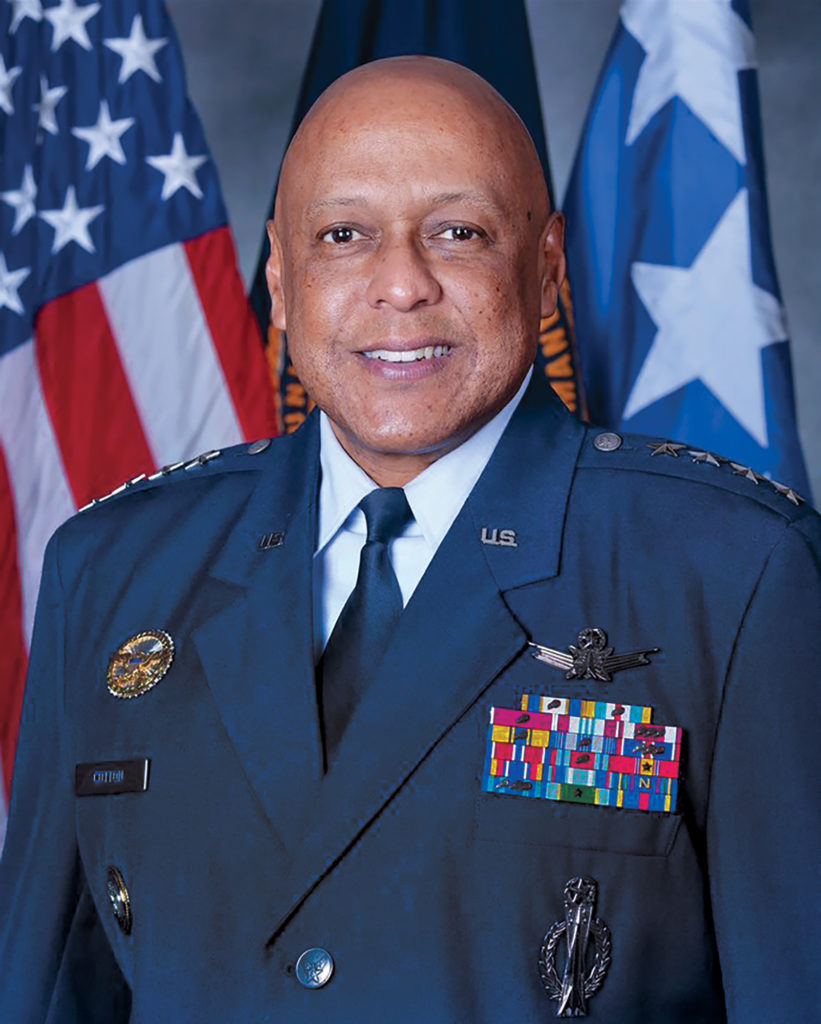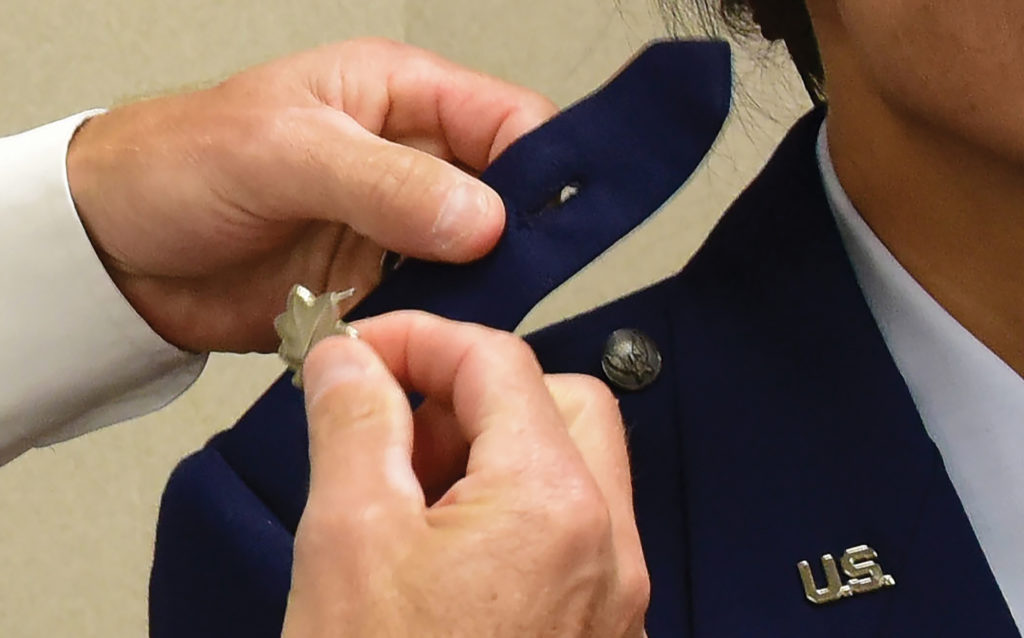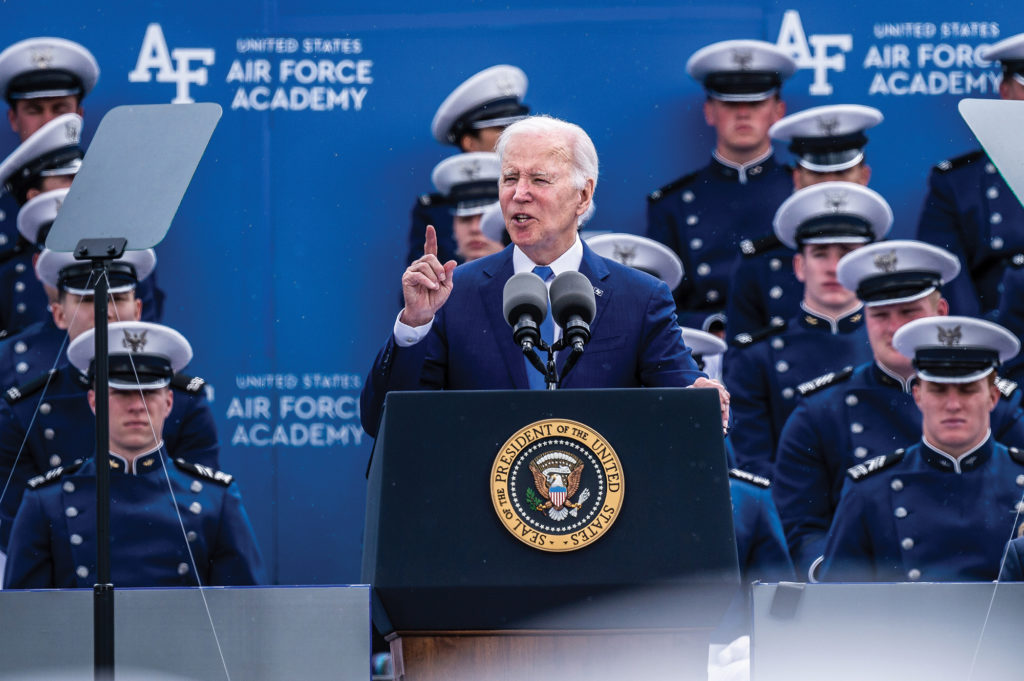CSAF Brown Nominated to Be Next Chairman
By Chris Gordon
For the first time since 2005, an Airman will chair the Joint Chiefs of Staff. President Joe Biden introduced Gen. Charles Q. Brown to the nation as “a proud, butt-kicking American Airman,” a reference to a recruiting commercial he shot early in his tenure.
Flanked by Vice President Kamala Harris and Secretary of Defense Lloyd J. Austin III on his right and Brown on his left, Biden noted Brown’s military lineage, the son and grandson of Soldiers. “General Brown is a warrior descended from a proud line of warriors,” Biden said in the Rose Garden ceremony. “He knows what it means to be in the thick of battle and how to keep your cool when things get hard.”
To illustrate, he noted how Brown survived an engine fire in an F-16 he was flying over the Florida Everglades in 1991. Forced to eject, he landed far from civilization, and was plucked out of the swamp. “I tell you what,” Biden said. “He was back in the cockpit the next week with a new call sign, ‘Swamp Thang.’”
With 3,000 hours of flying experience, including 130 combat hours, Brown’s career has been almost entirely operational. He commanded air operations over Syria in the Middle East and headed Pacific Air Forces before becoming Chief. He also commanded the Air Force Weapons School.
“He plays to win and that’s obvious,” Biden said. “That mindset is going to be an enormous asset to me as commander in chief and to the United States of America as we navigate challenges in the coming years.”
If confirmed—a formality in most cases—Brown will succeed Army Gen. Mark A. Milley as the President’s top military adviser. He would be just the fifth Airman to be Chairman, and the first since Gen. Richard Myers, who held the post from 2001 to 2005.
But timing and policy arguments could have an effect. Brown’s nomination is among more than 200 held up in a policy fight unrelated to the promotions themselves, but rather over Pentagon policy on funding travel for members in need of out-of-state abortion or reproductive health services. Sen. Tommy Tuberville (R-Ala.) placed a hold on the promotions this spring and has declined to remove it, despite mounting pressure.
Brown’s nomination could be handled separately, however, as was Milley’s; his 2019 nomination was approved 89-1.
Biden cited Brown’s signature “Accelerate Change … or Lose” directive. “Accelerate Change or Lose,” Biden repeated for emphasis. “General, you’re right on. … Our world is at an inflection point where the decisions we make today are going to determine the course of our world for decades to come.”
Milley, addressing reporters at the Pentagon, said Brown had “all the knowledge, skills, and attributes” a Chairman needs. “C.Q. is absolutely superb.”
“C.Q. is a fearless leader and an unyielding patriot,” Biden said. “I urge the Senate to once again confirm General Brown with the same overwhelming bipartisan support for his new role as Chairman of the Joint Chiefs of Staff.”
The President said he could rely on Brown to be “a thoughtful, deliberate leader who is unafraid to speak his mind, as someone who will deliver an honest message that needs to be heard, and who will always do the right thing when it’s hard. … That’s the No. 1 quality a President needs in a Chairman.”
The Most Likely Next Air Force Chief—and All the Contenders
By Greg Hadley
With President Biden selecting Gen. Charles Q. Brown Jr. as his choice to be the next Chairman of the Joint Chiefs of Staff, he must now decide who will follow Brown to become the 23rd Air Force Chief of Staff?
Vice Chief of Staff Gen. David W. Allvin, a career mobility and test pilot with an extensive operational and staff background, is the odds-on favorite. Quiet and cerebral, Allvin maintained a low profile for most of his tenure as the Vice, but took on an increasingly public role early this year, doing interviews and taking on additional public-facing duties.
Allvin is the 40th Vice Chief of Staff and would be the 10th former Vice to become Chief of Staff; he’d also be the third this century, following Gen. David L. Goldfein, Chief No. 21, and Gen. T. Michael Moseley, No. 18. His selection would also follow an emerging pattern: Marine Corps Assistant Commandant Eric Smith, the Corps’ No. 2 officer, is soon to succeed Gen. David H. Berger as Commandant.
As a leader on the Air Staff, Allvin has been a visionary helping to craft the joint force operating concepts advanced by three successive Chiefs: Gen. Mark Welsh, No. 20, along with Goldfein and Brown. He helped write “America’s Air Force: A Call to the Future” in 2014 and the “Air Force Future Operating Concept” in 2015, both critical precursors to what would become Goldfein’s vision for multidomain operations and, ultimately, what is now known throughout the services as Joint All-Domain Command and Control.
A test pilot with experience in more than two dozen aircraft, Allvin gained most of his command experience in air refueling and mobility units. But he has extensive Pentagon and joint experience, including stints in the Strategy, Plans, and Policy directorate of the Joint Staff. More recently, he has been a leading voice tackling the service’s challenges with recruiting and retention.
Others to watch:
Gen. James B. Hecker, Commander of U.S. Air Forces in Europe-Air Forces Africa. Hecker has overseen USAFE at a pivotal time in Europe, taking over not long after Russia’s invasion of Ukraine. His command has been on constant watch, with Airmen and aircraft operating in the skies and along the borders to reassure allies and secure NATO’s eastern flank. Hecker headed Air University prior to taking command at USAFE-AFAFRICA. A fighter pilot who flew F-15s and F-22s, he has commanded at the group, wing, and Numbered Air Force levels.
Three of the past seven Chiefs of Staff had commanded USAFE: Gen. Mike Ryan, Gen. John Jumper, and Gen. Mark Welsh.
Gen. Thomas A. Bussiere, Commander of Air Force Global Strike Command. As the head of AFGSC, Bussiere oversees the Air Force’s two legs of the nuclear triad, both of which are in the midst of massive modernization efforts that started years ago and will continue into the next decade. Under his command, AFGSC rolled out the new B-21 Raider in December 2022, which will be the “backbone” of the bomber fleet for years to come.
Bussiere has flown the F-15, B-1, B-2, and F-22, and led the 8th and 11th Air Forces. He was also vice commander of U.S. Strategic Command. He would be the first Chief to ascend from Global Strike Command, established in 2009, and the first bomber pilot to become Chief since Gen. David C. Jones in 1974.
Gen. Jacqueline D. Van Ovost, Commander of U.S. Transportation Command. A former test pilot who has flown a dozen aircraft types, Van Ovost would be the first woman to be Air Force Chief. Prior to leading TRANSCOM, she headed Air Mobility Command and before that was the Air Force’s Director of Staff at the Pentagon. She headed AMC during the record-breaking noncombatant evacuation operation from Afghanistan in 2021 and has overseen the massive logistical enterprise transporting materiel to Ukraine while at TRANSCOM.
Van Ovost has also led a reconsideration of TRANSCOM’s posture in the Pacific and helped to implement the Global Household Goods Contract for transporting troops’ possessions during moves. Two prior TRANSCOM commanders have gone on to become Chief of Staff—Gen. Ronald Fogleman in 1994, and Gen. Norton A. Schwartz in 2008.
Gen. Anthony J. Cotton, Commander of U.S. Strategic Command. Having only arrived at STRATCOM in December 2022, Cotton is a missileer whose prior command at Air Force Global Strike Command lasted less than a year before he was nominated to lead STRATCOM. If selected, he would be the first missileer to be Chief of Staff. Cotton was previously vice chief at AFGSC. He has commanded an Air Force Space Wing and was president of Air University.
Getting Promoted to Lieutenant Colonel Gets Harder for Operators
By Greg Hadley
The selection rate for majors in zone promoted to lieutenant colonel dropped slightly this year, while “above the zone” promotions continue to rise.
The Air Force unveiled an overhaul to its selection system in 2019, and instituted those changes in 2020, creating six competitive categories rather than have officers compete for promotion in a single group. The new system was supposed to make it easier for nonrated officers in logistics or intelligence, for example, to compete for advancement against rated officers, such as pilots and navigators.
The selection rate for Line of the Air Force majors promoted “in the zone,” which ranged from 76 percent to 77 percent since the change, dropped this year to 75.1 percent. Above-zone promotions, those for officers getting their second look by the promotion board, rose to 13 percent, the highest level since the change.
Early, or “below-the-zone” promotions, were eliminated in 2020.
Driving the shift is the air operations and special warfare category. Majors in this category, the largest in the Air Force, accounting for nearly half of those considered, were selected at a 74.4 percent rate, down nearly five percentage points from 2021.
“Above the zone” selections for operators were just 8.2 percent, the lowest in any category.
Selections also fell for information warfare officers, the second largest category. In-zone selections fell to 74 percent, down from 78.2 percent in 2021. However, the above-zone selection rate for information warfare officers tripled from 2021, rising from 6.4 percent then to 19.3 percent this year.
Combat support—the third largest category—which has seen fluctuating in-zone selections in recent years, saw an increase in “above the zone” selection.
When the Air Force announced its categories, the intent was to ensure officers competed to advance against peers with similar skills, career progression, and experience. Officials have since argued the system has also improved diversity, because women and racial minorities make up a greater portion of the nonrated officer community.
On the whole, more than 1,500 majors were in zone for consideration by the board, the largest cohort in at least four years. The group was likely larger because retention ticked up, related to the uncertainty of the COVID-19 pandemic, potentially creating a slightly larger cohort.
This year’s promotion cycle also marks the first time promotions boards have been able to see if potential lieutenant colonels have advanced academic degrees since 2014. The Air Force started “masking” those degrees because Airmen had come to see such degrees as a prerequisite for promotion—even if they had little to do with their career field.
In reversing that policy, Air Force Secretary Frank Kendall emphasized that advanced degrees are “neither a requirement for promotion to major or lieutenant colonel nor a guarantor of promotion.”
“The DAF will continue to value both operationally and educationally derived experience and expertise and will always value high levels of performance,” he added.
Different Rates for Different Groups
Some 1,576 majors were in the promotion zone, and another 1,042 got a second look from the 2023 Lieutenant Colonel Promotion Board. The overall in-zone selection rate was 75.1 percent and the above-zone rate was a scant 13.2 percent. But rates varied substantially among the six competitive categories.
CATEGORY | “In the Zone” Considered | “In the Zone” Selected | “In the Zone” Rate | “Above the Zone” Considered | “Above the Zone” Selected | “Above the Zone” Rate |
Air Operations & Special Warfare | 750 | 558 | 74.4 | 511 | 42 | 8.2 |
Nuclear & Missile Operations | 35 | 25 | 71.4 | 35 | 5 | 14.3 |
Information Warfare | 311 | 230 | 74.0 | 181 | 35 | 19.3 |
Force Modernization | 158 | 122 | 77.2 | 137 | 13 | 9.5 |
Combat Support | 265 | 201 | 75.8 | 162 | 38 | 23.5 |
Cross-Functional Operations | 57 | 47 | 82.5 | 16 | 5 | 31.3 |
Total | 1,576 | 1,183 | 75.1 | 1,042 | 138 | 13.2 |
Source: Air Force Personnel Center
Biden To USAFA Grads: A Rare ‘Chance to Change Trajectory’ of US
By Chris Gordon
Speaking at the U.S. Air Force Academy’s graduation ceremony June 1, President Joe Biden urged the Class of 2023’s 921 graduates “to keep us at the forefront of air and space dominance.”
This is a key point in history: “Your Airmen and Guardians are going to look to you for guidance and inspiration, because the world is going to get more confusing,” Biden said. “They’ll put their trust in you. You in turn must strive to always be worthy of their confidence. Listen to them. Listen to them.”
Russia’s invasion of Ukraine, competition with China, the impacts of climate change, and unknown challenges stemming from the rise of artificial intelligence will all change the world.
“We’re working across multiple domains developing new capabilities, like our new next-gen B-21 Raider,” Biden noted. “You’re going to be flying that sucker. We’re going to count on you to keep us at the forefront of air and space dominance, enabling the entire joint force.”
Speaking before Biden, Air Force Secretary Frank Kendall emphasized the importance of new technology and changing global dynamics to the new officers.
“You’re accepting a leadership role in a military in the midst of a strategic competition that is as great a challenge as we have faced in decades, certainly in my career,” said Kendall, who graduated from West Point 52 years ago. “You will be challenged to meet the requirements of our current missions while preparing for an uncertain future. You will be challenged to get everything you can out of today’s force to help build tomorrow’s force.”
Biden’s and Kendall’s remarks echo the National Security Strategy released last year, which referred to the 2020s as a “decisive decade.”
“The decisions we make today are going to determine what the world looks like decades from now,” Biden said. “No graduating class gets to choose the world into which they graduate. Every class enters the history of a nation up to the point that has been read by others. A few classes once every several generations, enters at a point in our history where they actually have a chance to change the trajectory of the country.”
